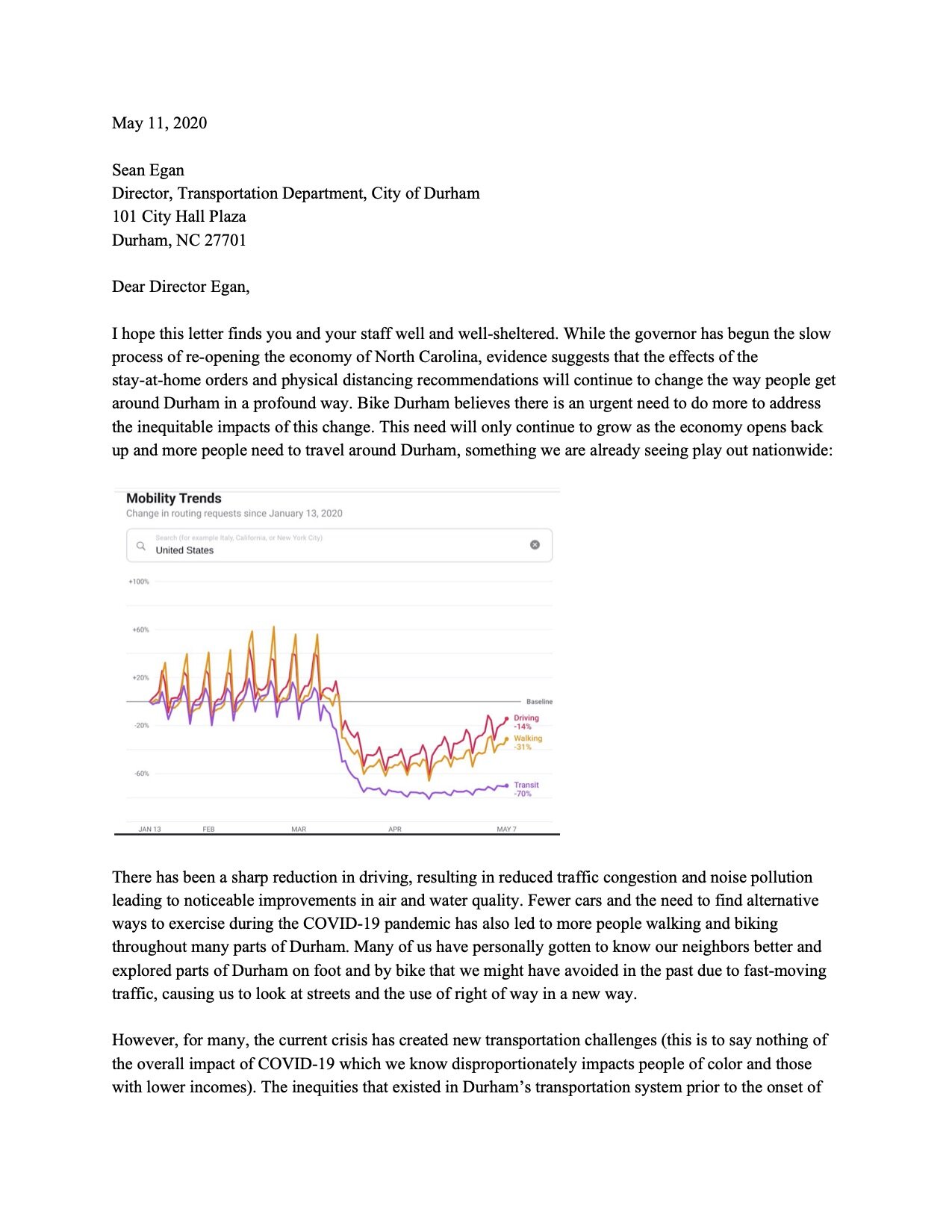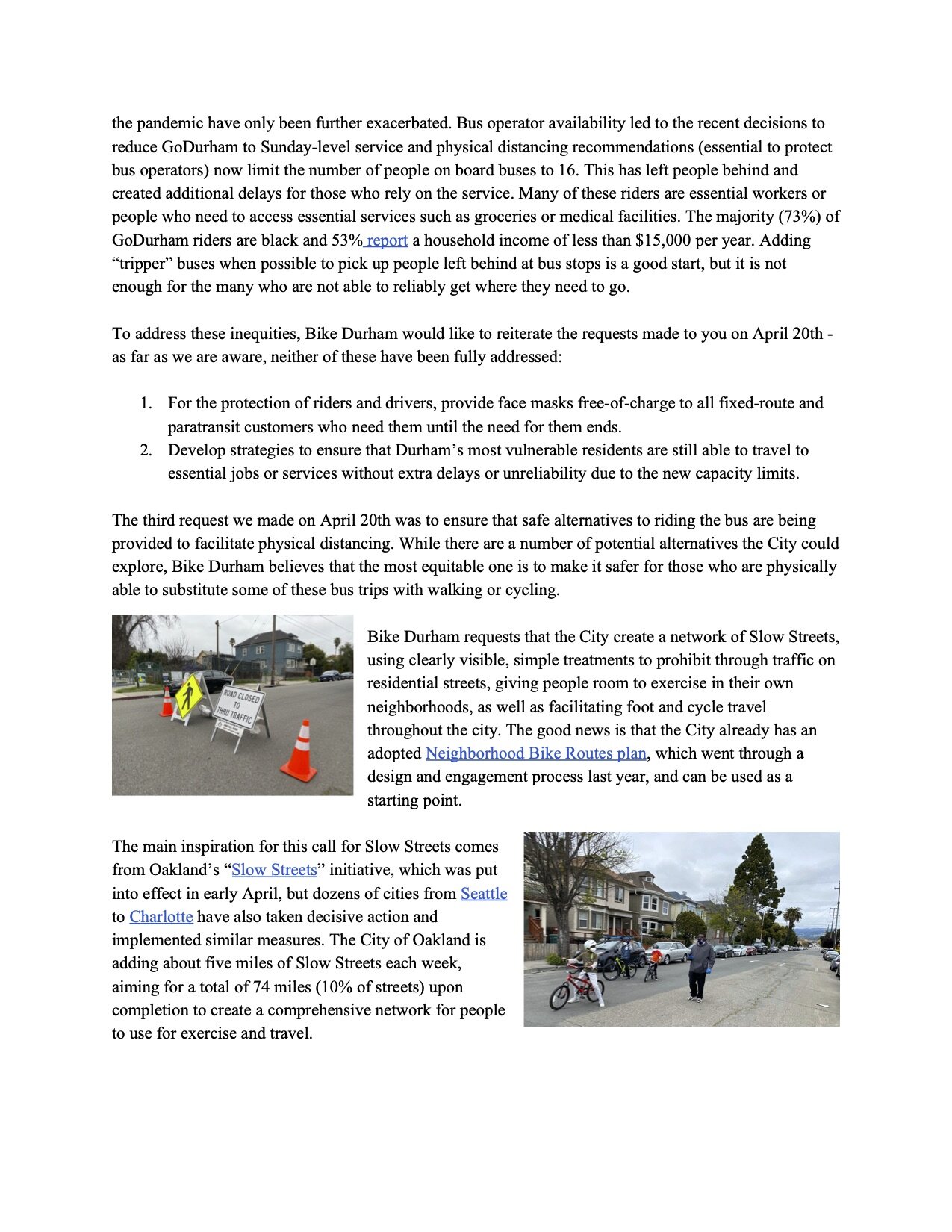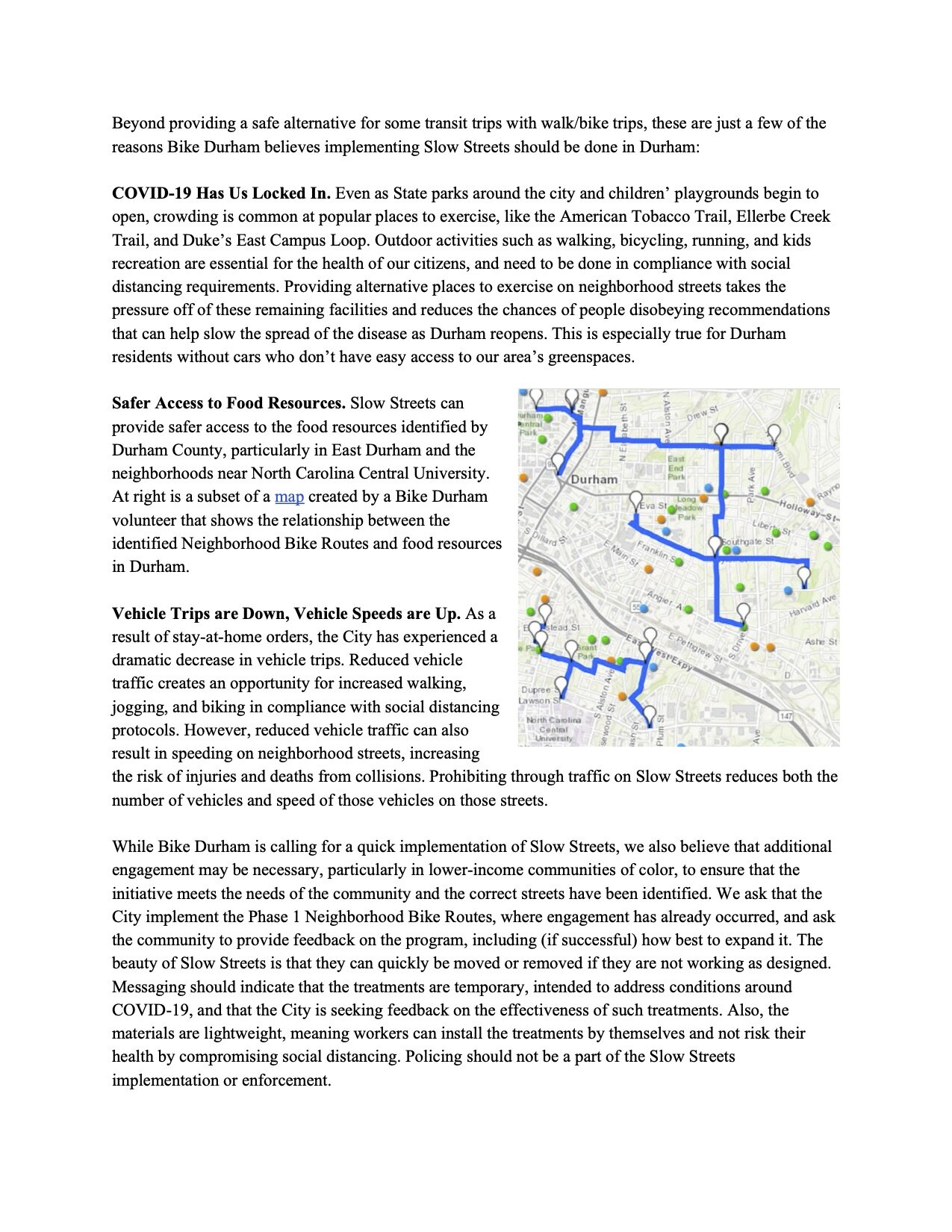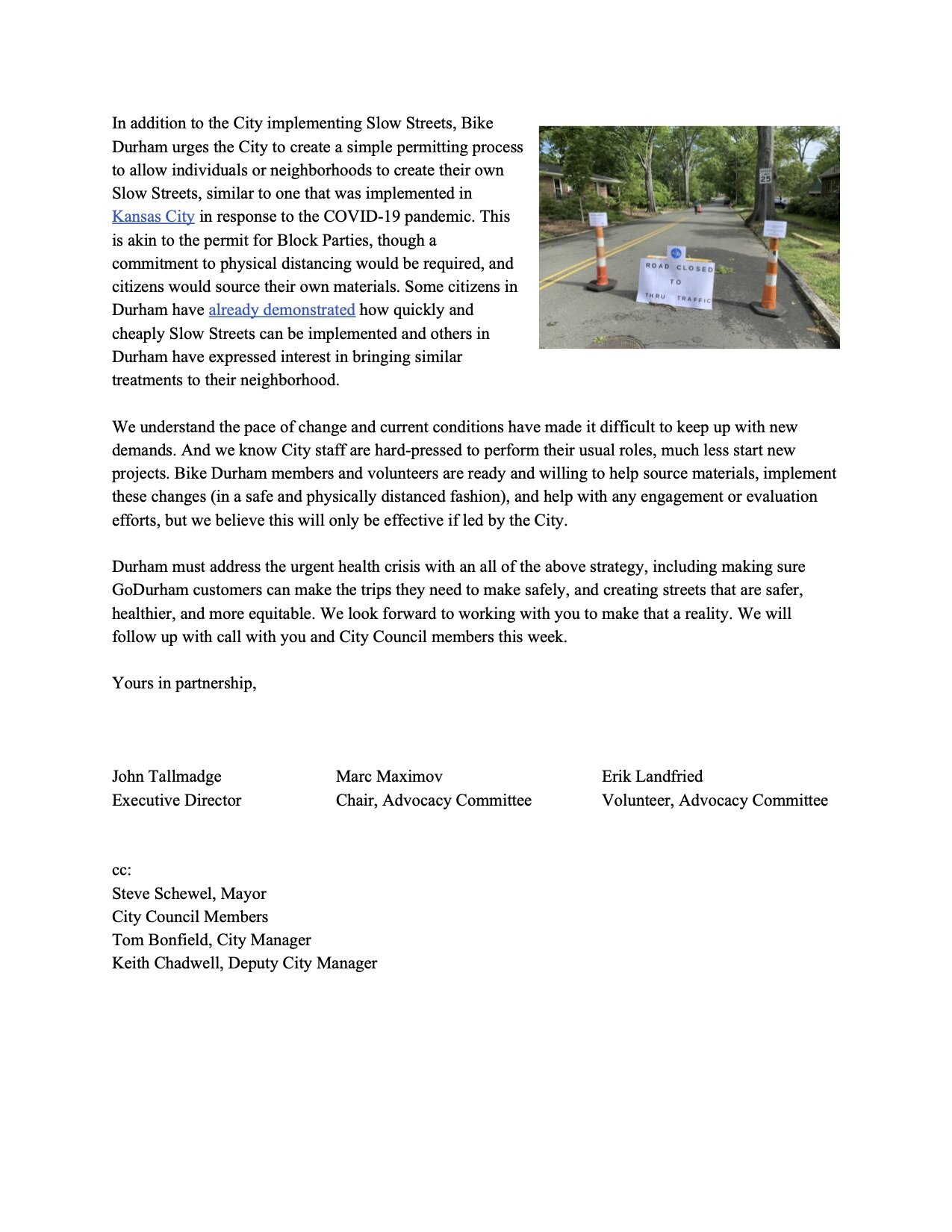CALL TO ACTION
The Durham-Chapel Hill-Carrboro Metropolitan Planning Organization (DCHC-MPO) is responsible for transportation planning for Durham and the western part of the Research Triangle area. On August 12, they held a public meeting to discuss their 2050 Metropolitan Transportation Plan (MTP) Goals and Objectives. This long-range transportation plan is updated every four years and guides transportation investments in the region.
While we agree with the inclusion of goals and objectives that go beyond the traditional measures of traffic speed and congestion delay we don’t believe that they are responsive to the values of our community. By 2050, we want to see zero disparity of access based on race and income, zero carbon emissions, and zero deaths and serious injuries on our streets and highways.
Please contact your elected officials on the MPO Board this week and ask them to direct staff to rewrite the goals to more clearly communicate the direction we want to go, and to rewrite the objectives to establish measurable outcomes for 2050 and interim years that will get us to zero disparity, zero emissions, and zero deaths. Ask them to vote against these goals and objectives unless they are changed.
You can view Bike Durham’s full recommendations on each of the Goals and their objectives below:
Goal: Protect the Human and Natural Environment and Minimize Climate Change
Objectives: Reduce mobile source emissions, GHG, and energy consumption; Reduce negative impacts on natural and cultural environment; Connect transportation and land use
We agree that this is a very important goal, and appreciate that the staff has included it. We believe the first objective should be net-zero carbon emissions from the transportation sector by 2050. The second and third objectives are directionally fine, but they do not specify the conditions we aim to achieve by 2050.
Goal: Connect People and Places
Objectives: Connect people to jobs, education and other important destinations using all modes; Ensure transportation needs are met for all populations (especially the aging and youth, economically disadvantaged, mobility impaired, and minorities)
We agree that this is an important goal, but we do not believe the language is adequate. We urge rewriting the goal as “Connect all people and places without disparity.” We urge the objective to be “Achieve zero disparity of access to jobs, education, and other important destinations by race, income, or belonging to a marginalized group.”
Goal: Promote and Expand Multi-modal & Affordable Choices
Objectives: Enhance transit services, amenities and facilities; Improve bicycle and pedestrian facilities; Increase utilization of affordable non-auto travel modes
While we support these strategies and tactics in achieving the goals of zero carbon emissions, zero disparity of access, and zero deaths on our streets and highways, the only goal defined here is affordability. We urge rewriting the goal as “Ensure that all have affordable access to the transportation system.” We ask that the objectives include: “No one should pay more than 40% of their income for housing plus transportation by 2050.” It may be valuable to establish objectives around the percentage of trips that use sustainable modes of transportation, but we would recommend that be established under the first goal, supporting the objective of zero carbon emissions, paired with an objective regarding the percentages of the motorized fleets that are electric.
Goal: Manage Congestion & System Reliability
Objectives: Allow people and goods to move with greater reliability; Promote Travel Demand Management (TDM, such as carpool, vanpool, telecommuting and park-and-ride); Enhance Intelligent Transportation Systems (ITS, such as ramp metering, dynamic signal phasing and vehicle detection systems)
We agree that system reliability is an important goal. By that, we mean that connections are available when people need them, and that travel times are predictable. Measures of congestion are not as important as measures of travel time predictability, and travel times should be comparable for all system users. "Objectives 2 and 3" are strategies, not objectives.
Goal: Improve Infrastructure Condition and Resilience
Objectives: Increase proportion of highways and highway assets in 'Good' condition; Maintain transit vehicles, facilities and amenities in the best operating condition; Improve the condition of bicycle and pedestrian facilities and amenities; Promote resilience planning and practices; Support autonomous, connected, and electric vehicles
This is a well-defined goal and set of objectives—except for the last one. The last objective seems to be a strategy, and doesn’t have a clear connection to the goal. Also, “improving conditions” should not be equated with expanding capacity. There is a long tradition defining any transportation project as an “improvement” (i.e., Transportation Improvement Program).
Goal: Ensure Equity and Participation
Objectives: Ensure that transportation investments do not disrupt communities; Promote equitable public participation among all communities
We agree with the goal; however, the first objective does not acknowledge that the existing transportation system has placed disproportionate burdens on low-income communities, especially Black communities, and on individuals without regular access to a car. One objective should be a transportation system with zero disparities of access based on race, wealth, income, gender identity, age, or ability. We urge rewriting the second objective to read, “Ensure equitable public participation among all communities: geographic, racial, age, income, gender, and ability.”
Goal: Promote Safety and Health
Objectives: Increase safety of travelers and residents; Promote public health through transportation choices
This is an essential goal. Objective 1 should be stated as zero deaths or serious injuries on our streets and highways by 2050. Objective 2 should be measurable, such as “All residents will have safe access to active transportation choices by 2050.” Interim targets should also be established.
Goal: Stimulate Economic Vitality
Objectives: Improve freight movement; Coordinate land use and transportation; Target funding to the most cost-effective solutions; Improve project delivery for all modes
While the goal seems laudable, it does not indicate for whom. When we don't indicate for whom we are stimulating economic vitality, there is usually a group left behind, and that group is usually those who are Black or brown, and at the lowest end of our income and wealth scales. If our transportation system is to become equitable, it needs to stimulate economic vitality for all socio-economic groups, with objectives, and ways to measure progress, set toward that goal. We recommend a replacement goal of “Enhance inclusive local and regional economic opportunity.”
Second, "improve freight movement" is ambiguous. Does this mean shorter freight travel times? Or greater predictability of travel times? If a goal suggests the direction we're going, an objective should communicate where we want to end up. Improving freight movement doesn't do that. Neither does the fourth objective. The third objective is important, but it isn’t specific to this goal. We want cost-effective solutions that achieve multiple goals.
We recommend the following objectives: Maximize local-hire opportunities in construction, operation, and maintenance projects; prioritize pedestrian and bicycle access to local businesses over automobile access and parking; promote transportation-related businesses in ways that help ownership reflect the demographics of the regional population by race and gender; and ensure projects that benefit the local community without displacing residents.

















